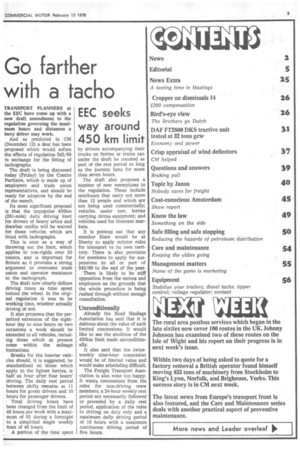Go farther with a tacho
Page 5

If you've noticed an error in this article please click here to report it so we can fix it.
EEC seeks
way around
450 km limit TRANSPORT PLANNERS at the EEC have come up with a new draft amendment to the regulation governing the maximum hours and distances a lorry driver may work.
And as predicted in CM (December 12) a deal has been proposed which would soften the effects of regulation 543/69 in exchange for the fitting of tachographs.
The draft is being discussed today (Friday) by the Comite Paritaire, which is made up of employers and trade union representatives, and should be ready for adoption by the end of the month.
Its most significant proposal is that the unpopular 450km (281-mile) daily driving limit for drivers of heavy artics and drawbar outfits will be waived for those vehicles which are fitted with tachographs.
This is seen as a way of throwing out the limit, which applies to non-rigids over 20 tonnes, and is important for Britain as it provides a strong argument to overcome trade union and operator resistance to the tachograph.
The draft now clearly defines driving times as time spent behind the wheel. In the original regulation it was to be working time, whether actually driving or not.
It also proposes that the permitted extension of the eighthour day to nine hours on two occasions a week should be extended to all vehicles, including those which at present come within the mileage Breaks for the heavier vehicles should, it is suggested, be standardised on those which apply to the lighter lorries, ie half an hour after four hours' driving. The daily rest period between shifts remains at I1 hours for goods drivers and 10 hours for passenger drivers.
Total driving hours have been changed from the limit of 48 hours per week with a maximum of 92 during a fortnight to a simplified single weekly limit of 46 hours.
A portion of the time spent by drivers accompanying their trucks on ferries or trains can under the draft be counted as pant of the rest period so long as •the journey lasts for more than seven hours.
The draft also proposes a number of new exemptions to the regulation. These include minibuses that carry not more than 12 people and which are not being used commercially; vehicles under test; lorries carrying circus equipment; and vehicles used for itinerant markets.
It is pointed out that any member State would be at liberty to apply stricter rules for transport to its own territory. There is also provision for members to apply for suspensions to all or part of 543/69 to the end of the year.
There is likely to be stiff opposition from the unions and employers on the grounds that the whole procedure is being rushed through without enough consultation.
Unconditionally
Already the Road Haulage Association has said that it is dubious about the value of such limited concessions. It would like to see the abolition of the 450km limit made unconditionally.
It also said that the twiceweekly nine-hour concession would be of limited value and would make scheduling difficult.
The Freight Transport Association is also none too happy. It wants concessions from the rules for non-driving crew members, a 24-hour weekly rest period not necessarily followed or preceded by a daily rest period, application of the rules to driving on duty only and a maximum daily driving period of 10 hours with a maximum continuous driving period of five hours.




























































































